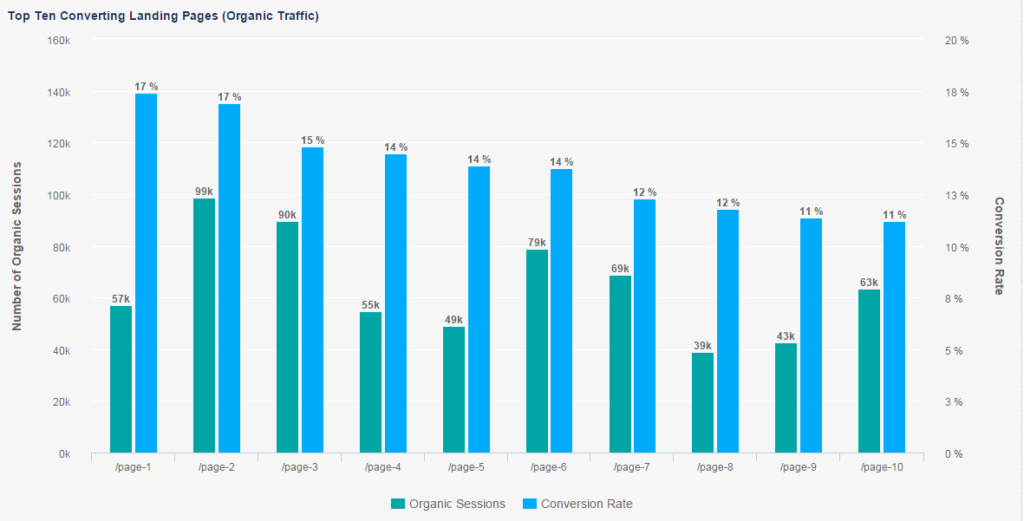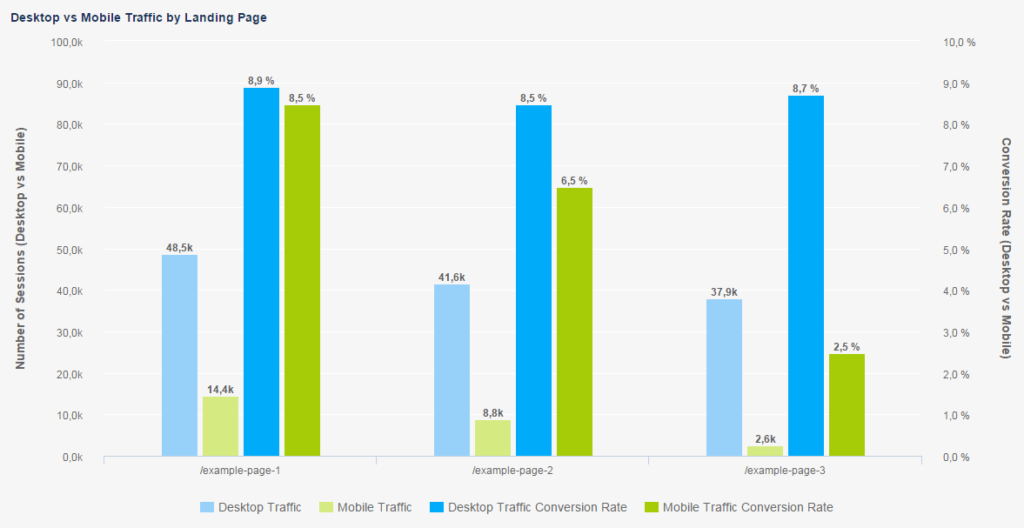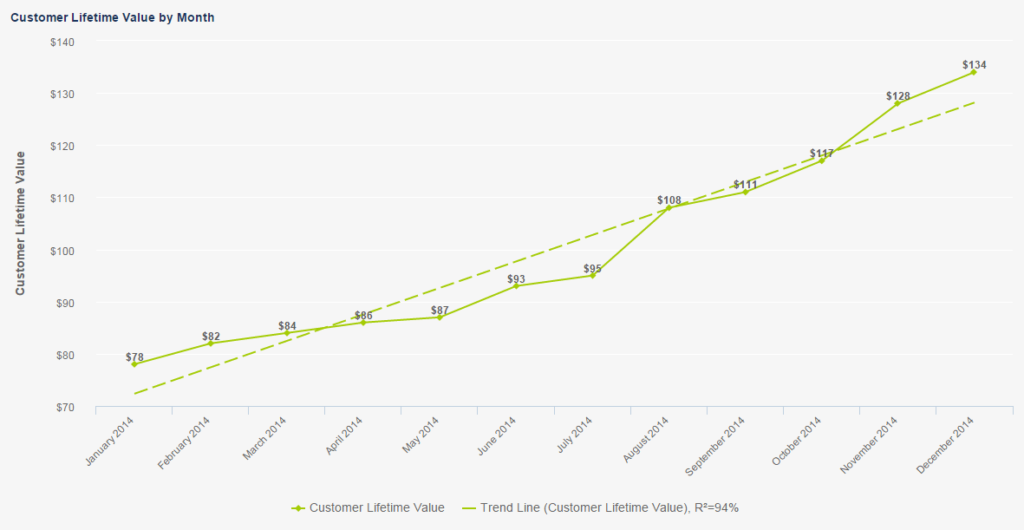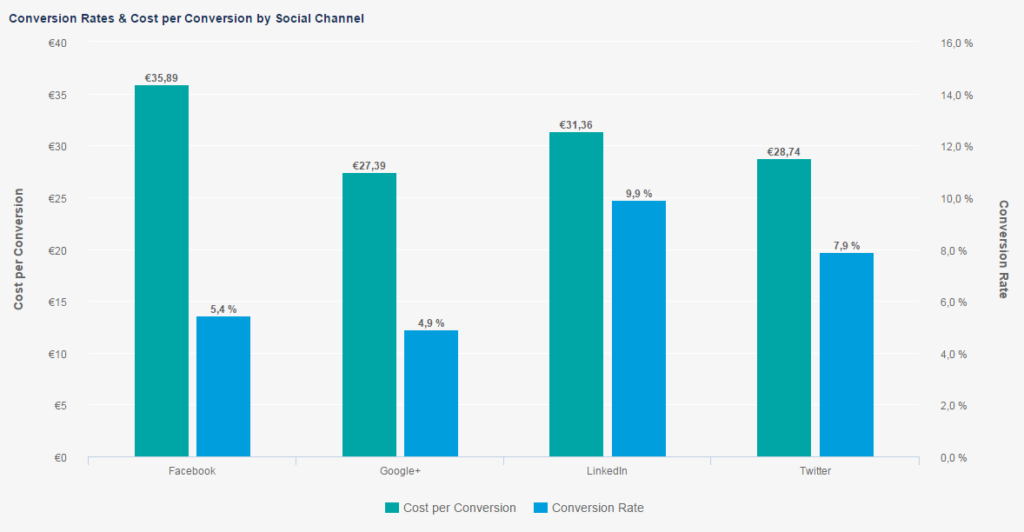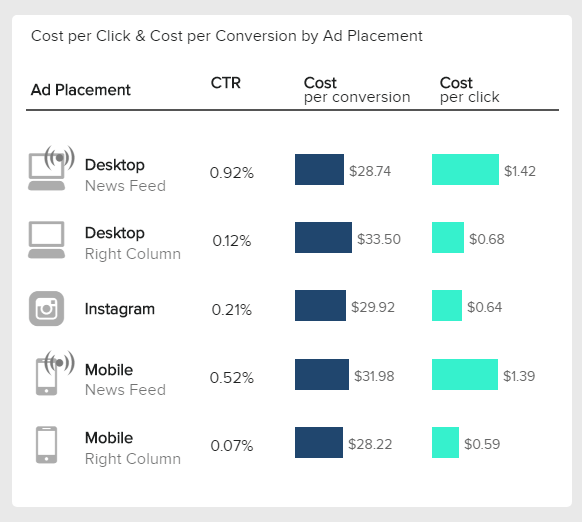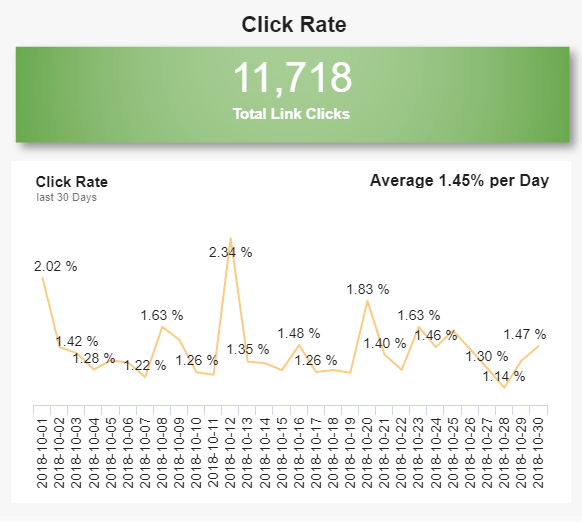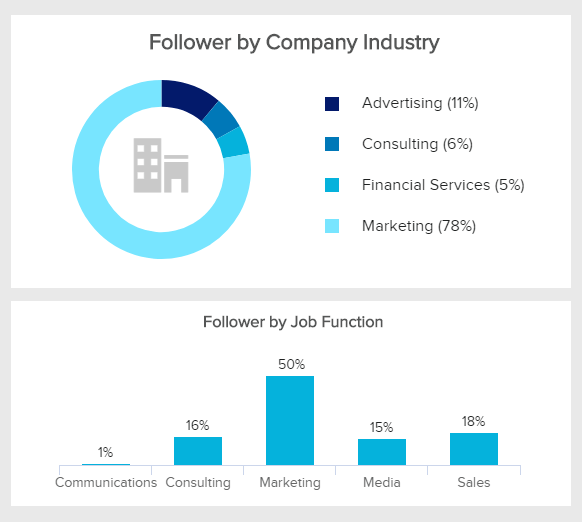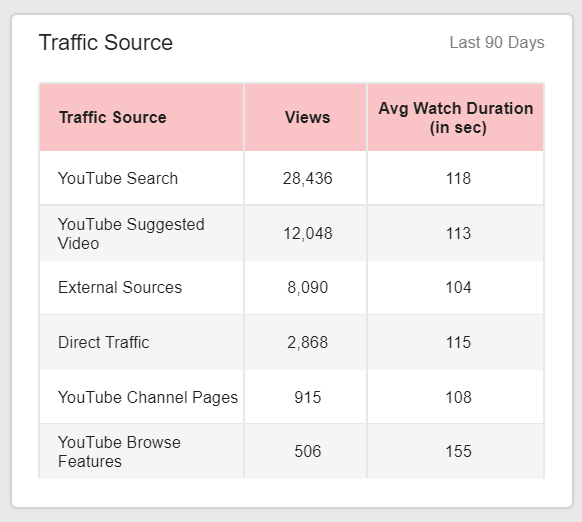In business, Key Performance Indicators (KPIs) help you see the big picture and evaluate your strategies to better adjust them. There are many different KPI examples that you can use to track and evaluate a company’s success. Measuring digital marketing KPIs is one of the crucial functions of a marketing department. Why?
Because digital marketing, more than any other form of marketing, thrives on the proper use of KPIs. With digital marketing, almost everything is quantifiable. You can see how much your marketing strategy is costing you each step of the way and understand how much Return on Investment you’re getting. However, along with this ability to quantify, challenges and questions arise. Some of these challenges include:
- What are the Key Performance Indicators for digital marketing?
- Will these online marketing KPIs accurately reflect your “wins and losses” in the real world?
- How can you “move the dial” on these KPIs in a positive way?
While these challenges are difficult, they’re very important to solve. Let’s start with the simple definition.
What Is A KPI In Digital Marketing?
Key performance indicators for digital marketing represent measurable values which give an indication of campaigns’ performance, conducted by marketing teams, in every digital marketing channel, be it in display advertising, social media, or search engine optimization.
By establishing the right KPIs for your business, you can increase the chances of your success, and ensure a positive ROI.
The Challenge And Opportunity of Digital
The world is moving further and further in the direction of digital. One huge example is the recent explosion of smartphones. Not long ago, cell phones were something you either used to call or text others. Not long before that, cell phones were as big as walkie-talkies and extremely expensive.
Now, you might have a Facebook Ad campaign specifically targeting smartphone users, as the advertising pool is larger on mobile than on desktop. Just take a look at this data from the Pew Research Center showing the percentage of U.S. adults that owned smartphones or cellphones at a given point in time:
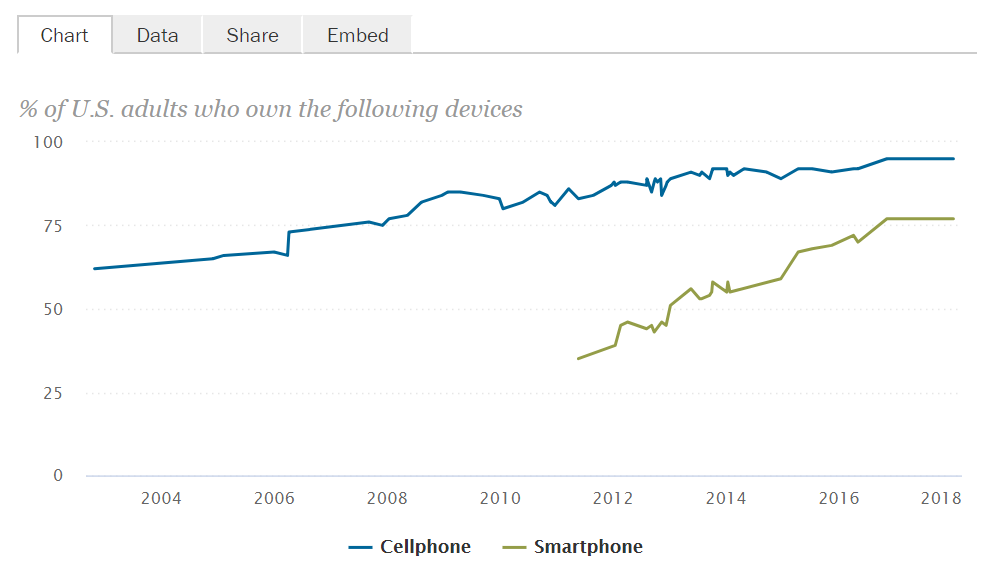
Smartphones only became “a thing” in 2011. And yet, within less than 10 years, more than 77% of U.S. adults now own a smartphone. This kind of fast paced change is becoming the norm in our modern, digital economy.
Every marketing action can be measured. The digital arena benefits businesses of all sizes, especially by utilizing a cost-effective budget. Unlike traditional media, like TV or print advertising, in digital you can set your targets more specifically and segment different interests of your audience, develop a truly personalized marketing strategy. You can find new markets and utilize the potential global reach, build customer loyalty and a community around your social media, or create immediate campaigns without having to wait for a specific media outlet to confirm your media plan.
However, many marketing departments are having a tough time keeping up with these extremely quick developments and changes. Digital marketing objectives is a specific breed. The ever-changing marketing industry keeps marketeers on top of their game, if they know how to evaluate their results and obtain a positive ROI.
But how do you know where to start?
Start With Your Fundamentals
First, start off with your standard digital marketing KPIs. These include Page Views, Bounce Rate, Conversion Rate, Return on Investment (ROI), etc. You can track them all thanks to the Google Analytics KPIs and metrics available in your GA account.
With that being said, a common error in setting digital marketing KPIs is to track too many of them. There are a lot of vanity metrics that appear important but don’t directly contribute to your bottom line. Vanity metrics can include things like:
- Facebook, Twitter, Pinterest followers
- The numbers of likes/shares your content is getting
- How many page views your website is getting
What these vanity metrics all have in common is that they’re surface level. They aren’t directly connected to ‘real’ business metrics, like revenue. Our philosophy in digital marketing is that “everyone must serve the bottom line.” This is a mindset with roots in direct marketing, as opposed to “creative” or “brand building” marketing that can’t show ROI.
So, if you want your marketing to have a solid ROI, you need to focus on online marketing KPIs that pinpoint on the areas of biggest impact. Some factors to consider when looking for tangible results are:
- Where are you spending marketing dollars?
- Is social media paying off in the long term?
- How many qualified leads are coming from mobile first?
- Are landing pages achieving set objectives?
- Is the right data dashboard properly setup?
Up until this point, we’ve been at a broad level overview of this topic. Now, let’s take a look at some digital marketing metrics.
The Top 5 Digital Marketing KPIs
1. Customer Acquisition Cost (CAC)
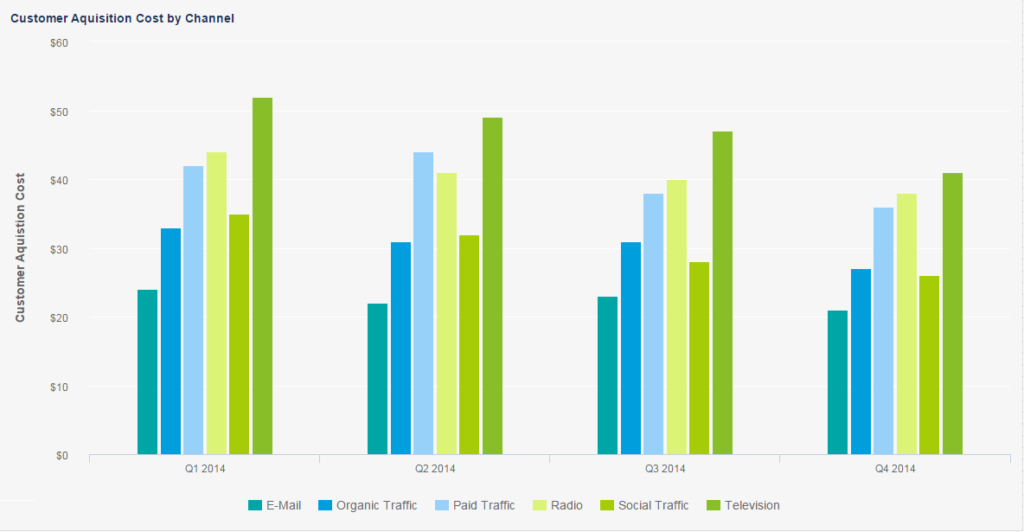
We will start our list of KPIs in digital marketing with Customer Acquisition Cost – the total spend required to convert a potential customer into a customer. CAC includes the product cost plus all other costs —such as research and marketing— spent on attracting a customer.
The old business adage “you can’t manage what you don’t measure” is on point when measuring your acquisition costs. Two common failures related to CAC primarily for start-ups are under budgeting for customer acquisition and not measuring data properly. According to Lon Safko, professional speaker and coach for social media strategy, “every business should look at its cost of customer acquisition at least twice a year and after each campaign”. Once per quarter is an even stronger, more usable metric.
For a deeper, more accurate look at the acquisition costs, split them into different channels or campaigns per quarter, like in the example chart above.
a) Organic Traffic
How much are you spending to increase your organic traffic? What are your true Customer Acquisition Costs for this channel?
It should be noted that this digital marketing KPI is difficult to track because there are often multiple players and efforts involved. You may not notice your site’s traffic increasing right away but it is important to pursue because the results are so valuable. The value starts to show when your site ranks high in an organic search. This lends credibility to your content. You are viewed as an expert and this builds trust with your visitors. Although customer trust often costs money, it cannot be bought. It has to be built.
The cost involved in increasing your trust is not a purchase but an investment. The investment, often substantial, is mostly upfront through building and maintaining your site to be search engine friendly. This pays off in spades and is easy to build into your long-term digital ROI and spread over a depreciation period, while the monthly maintenance fees factor easily into the cost of customer acquisition.
b) Paid Traffic
Second dimension of this digital marketing KPI is the paid traffic. Paid traffic can require a steep monthly budget, depending on the keywords you are bidding on or display ads you are placing. The costs (and the results you get from them) greatly depend on your execution. Your execution depends on a number of things, such as:
- How well you know your customers and your niche
- Your understanding of consumer psychology
- Your copywriting skills
- Your comfort with the ad platform and how relevant your ads are
A digital marketer knows their niche and customers inside and out. They know how to position a strong value and offer in a way that’s relevant to the ad platform which can almost literally “print money” for their business. A marketer who’s just throwing money into Facebook because they’ve heard that’s what everyone else is doing will have a tough time justifying the costs of their efforts.
However, it must be said that there’s a monetary “learning curve” to any ad platform that can be viewed as a necessary up-front cost to long term success. A PPC (Pay Per Click) campaign can be the perfect effort for specific, stand-alone needs such as the introduction of new products or services. With PPC, it’s easy to see the returns for each campaign if you are tracking the right digital marketing metrics, such as:
- How much did we spend on a particular campaign?
- How many leads converted from a particular paid campaign?
- How many of those leads turned into paying customers?
- What was the average lifetime value of those customers?
- How do these metrics compare with customers acquired through other channels?
As a final note, even veteran, expert advertisers will admit that on any ad platform, one eventually hits a point of “diminishing returns” where your additional dollars start to perform in a subpar way. Additionally, paid traffic campaigns must be constantly monitored to ensure that they’re performing well.
That’s why it’s so important to utilize other traffic sources as well — so that your company isn’t reliant on any one source of new business.
c) Social Traffic
When measuring and conducting digital marketing KPI monitoring, social traffic plays a role. How much do you want to invest in social each month? Engagement may be the goal of social traffic but conversions are the goal of your business. Are the social channels achieving conversion? Are you producing enough enjoyable content and is it being published on the right platform?
For example, if you are trying to engage an executive audience, LinkedIn might be the better platform even if Facebook has the larger audience. If you’re interested in getting better at Facebook Ads, you can read our guide about the Facebook ads KPIs you should track, or this Youtube channel on how to advertise on Facebook.
d) Email Marketing Campaigns
Tracking open and click-through rates are fundamental digital marketing KPIs for building longer-term drip campaigns. Do customers consume the content you are sending out? Do you have a solid content strategy? Are your emails building a relationship with your target audience or alienating them due to inbox clutter? Keeping track of all these digital marketing metrics will help refine your campaigns with each send.
Be especially aware of “list burnout,” which occurs when you send your customers non-relevant information too many times. This can be seen in your digital marketing KPIs as a gradually declining average open rate on your emails. To avoid this, it’s wise to use segmentation. This is where you group your customers into different “lists” based on their interests.
One easy way to do this is to have a main email sequence that all of your new leads receive, with a broader focus. Within that email series, you can link to articles or other useful resources that are more “niched down” in nature. Then, using your email marketing provider, you can “tag” leads who click on those links.
For example, if you were a digital marketing agency, you could have the niches such as Facebook Ads, Google Adwords, Content Marketing, and Content Strategy, and then different lists for each.
Then, if you produced a new article on how Facebook ads can be a powerful tool for B2B businesses, you would only send an email with the article’s link to your “Facebook Ads” segment. In doing so, you ensure a high open rate on all of your emails, and you avoid sending emails that your leads have no interest in.
e) Television/Radio/Non-Digital Advertisement
We will continue our list of KPIs for digital marketing with the more traditional media. Although it can be difficult to track visitors that find your site because of a radio or TV ad, it is useful to know the impact of non-digital marketing efforts.
Tracking this involves comparing traffic with media flights (dates they ran). Were there any spikes during the campaign? If not, is a media strategy a worthy investment when digital might suffice? If there were relevant changes in traffic, it might be worth pursuing offline efforts.
Since businesses have been able to track KPIs, Customer Acquisition Cost has been at the top of the list. If you don’t understand which of your expenses are simply that, and which are investments, you are merely gambling. A well-designed CAC can highlight where you are making wise investments and where you are simply throwing money away.
2. Landing Page Conversion Rates
3. Mobile Traffic Conversion Rates
Our third digital marketing KPI concerns the predicted shift that has finally happened; users are now accessing more websites from mobile devices than desktops. According to a study released by comScore, U.S, users are now spending the majority of their time consuming digital media within mobile applications.
Smartphones and tablets are accounting for more web browsing traffic than ever. If your site isn’t optimized for mobile devices, you’re missing a key demographic. Not only is the number of visitors who find you on mobile relevant, but it’s also how effective your mobile presence is.
Google’s mobile-friendly update will keep the bounce rate in check but you should track conversion rates for mobile traffic (and landing pages optimized for mobile) as well. Initially, agencies were the only ones designing with mobile first in mind, which was an important start in optimization. Now all digital marketers have to catch up and think more broadly about what mobile first means for marketing. Not only should websites be optimized for mobile but marketing strategies should be as well.
Google’s Universal Analytics gives you all the options needed to track your Mobile Traffic Conversion Rate. A user searching for your site on any device is the same person, even when they switch devices. The Universal Analytics user ID associates multiple sessions with a single user giving you a more accurate view of your visitors and their behavior.
Understanding mobile traffic conversion can take some time and you may find you need to tweak campaigns regularly to achieve results. For example, in the chart above you see that in the first campaign, desktop and mobile are achieving approximately the same conversion results; a success!
In the second campaign, there is a little bit of room to optimize mobile efforts. The third campaign clearly has issues. The low mobile conversion rate shows flaws in mobile marketing efforts. Perhaps Google has marked this page as mobile unfriendly. This one requires immediate attention and possibly a new strategy.
4. Customer Lifetime Value (LTV)
We continue expounding measures of digital marketing with Customer Lifetime Value (LTV) – a metric used to predict the profit you’ll generate from your relationship with your customers. It’s important to understand how it’s linked to the Customer Acquisition Cost. In one of our previous blog post on the Top 5 SaaS KPIs every company should track, we explained the relation between LTV, Customer Acquisition Cost, and Average Revenue Per User (ARPU) in detail.
LTV is reasonably simple to calculate but often overlooked. It allows you to determine the buying history of your audience. This information is valuable because it helps determine whether or not you need to invest more into customer acquisition or customer retention.
In theory, the smaller the customer lifetime value, the more new customers are needed. In turn, the higher the customer lifetime value, the fewer new customers are needed. This simple equation shows you how to spend your marketing dollars and shows you how to target your efforts.
With a good inbound marketing automation in place, most of the information should be gathered for you. How you translate that information will determine the success of your strategies. Basically, LTV is the projected revenue that a customer will generate during their lifetime.
If properly calculated we can determine how much customers spend, how often they spend, and what loyalty programs have incentivized them to keep spending. These are the “happy customer” metrics. Investing in retention by keeping your customers happy shouldn’t be undervalued and it might not be necessary to spend as much on attraction.
Visitor Loyalty
Similar to LTV is visitor loyalty. This KPI for non-Ecommerce sites is very useful. If your site does not require a sale for a conversion, this metric can measure loyalty and recent visits. Be careful when reporting Visitor Frequency though, as most web analytics tools will automatically put New Visitors into those counts. Make sure to filter them out to better understand the loyalty component.
With the wealth of information available, it can be overwhelming when choosing which digital marketing KPIs are best to track. By using these top five digital marketing metrics, you can start to identify areas that need attention because nothing (or the wrong thing) measured means nothing gained.
But now, let’s take some action. First, take a thorough look at your current customer acquisition channels. Which ones are giving you the best ROI in terms of CAC versus LTV? Next, decide if there are any channels that you should actively stop using due to lack of results. Finally, design a new digital marketing strategy, keeping in mind what’s been working well for you in the past.
5. Social Media Performance
It’s no secret that the advent of social media can be a rabbit hole for marketers. It seems intangible and fleeting. Every tweet lasts only a moment and status updates are a passing thought.
There are some important KPIs for digital marketing to track though. A well-suited metric for your Social Media Reach allows you to show executives the effectiveness of their social media presence. This digital marketing KPI can measure things such as the number of likes, retweets, shares, etc. These metrics are only important in relation to other, revenue related metrics.
You can also measure more complicated data, such as the number of leads generated from each social media platform and what percentage of traffic is coming from each. In order to understand what you need from your social metrics, some questions to consider are:
- How many people get to your site via social media?
- Who are these people and which SM platform did most of them come from?
- Investing in enjoyable content is important but which content is working?
- Which social-media outlets are the most cost effective?
- Which sites are converting?
Creating valuable data reports to visualize your social media data will help you understand the status of your campaigns at a glance.
In the chart above you’ll notice the conversion rates of social media channels. LinkedIn is the strongest at converting visitors with a 9.9% conversion rate. Twitter is a close second, which is valuable information when building your social strategy. However, when you look at the Cost per Conversion, which should matter most for digital marketers, Google+ is the most effective and cost efficient. In this case, you would get more conversions for your money, even if your conversion rate is less effective than LinkedIn. And yes, Google+ is shutting down, but we clearly use examples to depict some scenarios. The real strategy and social media channels you choose, depend on your specific business and goals.
Since the social media arena today is one of the most important marketing channel companies are investing into, despite the recent regulations via GDPR (General Data Protection Regulation) and CCPA (California Consumer Privacy Act), we will focus on digital marketing KPI examples from popular channels like Facebook, Twitter, LinkedIn, and YouTube. We will also suggest some tools to measure digital marketing performance, that will make the life of any social media or marketing manager much easier.
Let’s start with the most used social media channel in history – Facebook.
a) Facebook
Facebook has a number of digital KPIs a social media professional can track and analyze. From the Number of Fans to Page Views, or Cost per Conversion – depending on the budget and the time invested, different Facebook KPIs will bring different results.
Conversion is the Alpha and Omega of social media KPIs. You cannot expect a positive ROI if conversions of your marketing efforts don’t happen. That means even if you have millions of followers, but they don’t perform specific actions and don’t participate in your strategy, all of your efforts could be compromised and results seriously affected. With the right tools to measure digital marketing performance, including social media channels like Facebook, you can set a healthy practice by utilizing the right KPI software which will decrease your operational costs. Let’s see this through an example.
On the example above, the Cost-per-Conversion is tightly correlated with the CTR (Click-through-Rate) and CPC (Cost-per-Click). It is important to measure and evaluate correlations of these digital KPIs so that you can understand where your costs are coming from. The placement of these key metrics in online marketing greatly affects the performance of your ads. It could happen that the Right Column has a lower CPC, but a higher Cost-per-Conversion. Therefore, it would make sense to establish a KPI report that can help you to collect and analyze data in more detail.
b) Twitter
Twitter is another social media gem that can increase the overall value of online advertising metrics and analysis. To conduct your own analytical reporting, setting the right Twitter KPIs should be one of top marketing priorities. You can post beautiful content, but if you don’t know how to track it or analyze it, your marketing efforts will not provide the desired results. Let’s see this through additional digital marketing KPI examples.
On this example above, the results of a specific campaign are tracked based on your established goal. In this case, our digital KPI is the Click Rate performed in the last 30 days. This KPI for digital marketing expounds also on the average percentage which can tell you whether your strategy is performing as planned. Certain spikes in this marketing report can additionally provide insights into your most successful posting day, time, and audience interest in your ads.
c) LinkedIn
If you want to fully take advantage of your KPI management process, using LinkedIn as a mean of promoting your business, product or service should be also incorporated into your strategy. Especially if the strategy is concentrated on B2B. LinkedIn is a business platform, designed to connect business professionals and companies. You can take advantage of LinkedIn KPIs that if you know how to target your audience.
Since targeting is one of the main focus when designing a marketing strategy, we will focus on the demography, one of the main KPIs in digital marketing to consider when you want to achieve your goals. Why? It is simple. You cannot target teens on LinkedIn if their main social media is YouTube. That’s why research is important.
Although this KPI in digital marketing isn’t directly corelated with the return on investment, it is important in every aspect of social media posting and strategy since your audience profile is the core of your marketing efforts. If you are a business that is targeting men under the age of 40, marketing executives in the USA, you have to adjust your strategy accordingly. On the example above, we can directly see the percentage of followers by industry and job function. This can directly set the type of content you can share and define whether you want to target additional industries and job functions –that’s why we have included the demographics as one of the key metrics in online marketing.
It also wouldn’t make sense to post your content during the evenings, if your business is located in a different time zone than your audience. That could directly affect your results, which, at the end, will decrease your ROI.
By setting an analytical report, the digital marketing KPI monitoring process can quickly become much more convenient – they are essential for a healthy business environment, and social media is no exception.
d) YouTube
Let’s face it – video is the king these days. With more than 1.9 billion users worldwide, the only platform that has more is Facebook. That being said, the potential of utilizing YouTube in your marketing strategy is immense. Viewers that watch more than 30 seconds of a video are 23 times more likely to visit, subscribe or share the brand’s channel.
Therefore, YouTube metrics shouldn’t be disregarded or underutilized. But let’s see how we can see this in a practical KPI for digital marketing.
As part of the online advertising metrics and analysis, the Traffic source can define where to allocate your marketing resources. As viewers are more likely to conduct a specific action (if they watch your videos more than 30 seconds, as mentioned earlier), then you should be able to define which Traffic source is your main point of interest.
Another factor to keep in mind that some Traffic sources have a higher CTR, like YouTube Search, because Search viewers have a higher intent to watch.
The notion that social is a free arena of captive users is not only dated, but this arena of users has shown us that they won’t even listen unless we produce quality content. No matter what you are hoping to achieve through social, if you don’t create interesting, useful, and ideally pretty content you won’t even get a visit, let alone a conversion. Formulating social media engagement is serious business. A strong content strategy with well-defined digital marketing KPIs will show you what’s working and what isn’t.
The Invaluable Measures Of Digital Marketing – KPIs
We have defined what is a KPI in digital marketing, selected the top metrics to measure, and provided marketing KPI examples that can benefit any serious marketing strategy. It is important to create your own specific plan. Optimization and evaluation of the campaigns should be your next focus. Highlight what is working, and what not. Make room for improvement. Identify areas of failure and specific actions on how to improve them. You don’t need an extensive list of KPIs and track all of them, but considering which ones are the most important and how they can help you reach your marketing goals, should be the top priority before setting and conducting a campaign. That’s the meaning of the letter K in KPI – key, influential, critical.
As a closing note, data from KPIs is much easier to understand in a visual format than in a spreadsheet. Reporting tools that can make sense of the vas amount of data being collected in recent years, can directly provide stakeholders with the right information at the right time.
You can find this out for yourself through a free trial of datapine’s data visualization software. It’s intuitive and you can start building compelling business dashboards in a couple of clicks, which leads to actionable insights that can help your company become more profitable.
To summarize our article, here are the top digital marketing KPIs:
- Customer Acquisition Cost (CAC)
- Landing Page Conversion Rates
- Mobile Traffic Conversion Rates
- Customer Lifetime Value
- Social Media Performance
Source: The datapine
Exclusive Bonus Content: Your digital marketing cheat sheet is waiting!
Download it for free and boost your return on investment!


